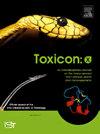Synthesis of U-theraphotoxin-Pv1a_1, an Aedes aegypti larvicidal disulfide bridged peptide from the Colombian tarantula Pamphobeteus verdolaga (Araneae: Theraphosidae)
IF 2.8
Q2 TOXICOLOGY
引用次数: 0
Abstract
The attention to the increased resistance of Aedes aegipty to traditional insecticides has been directed to the development of bioinsecticides, such as those produced by insect predators, e.g. spiders. Here we present the solid-phase synthesis of native U-theraphotoxin-Pv1a_1 (n-Pv1a_1) from Pamphobeteus verdolaga, an active (by contact) insecticidal peptide against A. aegipty. U-theraphotoxin-Pv1a_1 sequence was gathered from venom proteomics and venom gland transcriptomics of Pamphobeteus verdolaga, and synthesized by solid phase using the Fmoc strategy followed by dimethyl sulfoxide promoted native disulfide bond formation. The synthetic peptide (s-Pv1a_1) was assayed for larvicidal activity in II and III instar A. aegypti larvae, as well as for cytotoxicity in human red blood and HaCat cells. s-Pv1a_1 showed potent activity towards A. aegypti larvae in the micro molar range, while showing no hemolytic activity and mild cytotoxicity to HaCat cells. Its potent contact activity makes n-Pv1a_1 and its synthetic version, s-Pv1a, promising biopesticides for the control of mosquito populations.

哥伦比亚狼蛛Pamphobeteus verdolaga二硫桥接肽U-theraphotoxin-Pv1a_1的合成(蜘蛛目:狼蛛科)
对伊蚊对传统杀虫剂的抗性增加的关注已经指向生物杀虫剂的开发,例如由昆虫捕食者(如蜘蛛)产生的生物杀虫剂。本研究采用固相法合成了一种有效的(接触)杀虫肽U-theraphotoxin-Pv1a_1 (n-Pv1a_1)。U-theraphotoxin-Pv1a_1序列采集自Pamphobeteus verdolaga毒液蛋白质组学和毒液腺转录组学,采用Fmoc策略,二甲亚砜促进天然二硫键形成,采用固相法合成。测定合成肽s-Pv1a_1对II龄和III龄埃及伊蚊幼虫的杀虫活性,以及对人红细胞和HaCat细胞的细胞毒性。s-Pv1a_1在微摩尔范围内对埃及伊蚊幼虫表现出较强的活性,而对HaCat细胞无溶血活性和轻微的细胞毒性。n-Pv1a_1及其合成产物s-Pv1a具有很强的接触活性,有望成为控制蚊虫数量的生物农药。
本文章由计算机程序翻译,如有差异,请以英文原文为准。
求助全文
约1分钟内获得全文
求助全文
来源期刊

Toxicon: X
Pharmacology, Toxicology and Pharmaceutics-Toxicology
CiteScore
6.50
自引率
0.00%
发文量
33
审稿时长
14 weeks
 求助内容:
求助内容: 应助结果提醒方式:
应助结果提醒方式:


